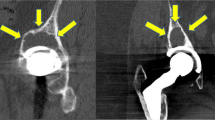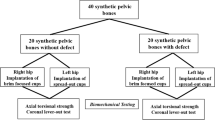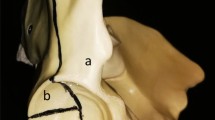Abstract
Introduction
Total hip replacement has been established as a valid treatment option for displaced subcapital fractures. However, insufficient primary fixation may be the reason for early loosening in these osteoporotic patients. Primary fixation of the cup is usually achieved by press-fit fixation that can be enhanced using screws. Locking the screws into their respective cups may seem to improve the primary fixation of the construct, as locked plates proved superior fixation for osteoporotic fractures.
Methods
The study consisted of three groups: in each group, three cups were fixed into blocks of foam bone using press-fit technique. In the first group, no additional screws were used, in the second group two standard screws were inserted, while in the third group two acetabular screws were cemented into the cup to simulate locked screw fixation. Load was applied onto the rim of the acetabular component to cause shearing between the cup and the block. Cup fixation was examined by a loading machine that acquired load versus displacement. The stiffness (load vs. displacement) was calculated.
Results
Screws, either locked or non-locked, enhanced cup fixation by 26 % (p value <0.01). No significant changes were found between the locking and non-locking screws groups.
Discussion
These experimental results indicate that acetabular screws enhance primary cup fixation. This may become significant in conditions where the acetabular bone stock is suboptimal, such as when performing total hip arthroplasty after displaced subcapital fractures. However, there is no superiority for locked screws over standard screw fixation.




Similar content being viewed by others
References
Learmonth ID, Young C, Rorabeck C (2007) The operation of the century: total hip replacement. Lancet 27(9597):1508–1519
Furnes O, Havelin LI (2006) The Norwegian arthroplasty register report 2006. s.l.: Helse-Bergen HF, of Orthopaedic Surgery Haukeland University Hospital
Kärrholm J, Garellick G, Rogmark C, Herberts P (2008) Swedish hip arthroplasty register—annual report 2007. s.l. Department of Ortopaedics Sahlgrenska University Hospital
Litsky AS, Pophal SG (1994) Initial mechanical stability of acetabular prostheses. Orthopedics 17(1):53–57
Schwartz JT, Engh CA, Forte MR, Kukita Y, Grandia SK (1993) Evaluation of initial surface apposition in porous-coated acetabular components. Clin Orthop 293:174–187
Szmukler-Moncler S, Salama H, Reingewirtz Y, Dubruille JH (1998) Timing of loading and effect of micromotion on bone–dental implant interface: review of experimental literature. J Biomed Mater Res 43:192–203
Udomkiat P, Dorr LD, Wan Z (2002) Cementless hemispheric porous-coated sockets implanted with press-fit technique without screws: average ten-year follow-up. J Bone Joint Surg Am 84:1195–1200
Roth A, Winzer T, Sander K, Anders JO, Venbrocks RA (2006) Peress fit fixation of cementless cups: how much stability do we need? Arch Orthop Trauma Surg 126:77–81
Hsu JT, Chang CH, Huang HL et al (2007) The number of screws, bone quality, and friction coefficient affect acetabular cup stability. Med Eng Phys 29:1089–1095
Haidukewych GJ (2004) Innovations in locking plate technology. J Am Acad Orthop Surg 12:205–212
Perren SM (2001) Evolution and rationale of locked internal fixator technology–Introductory remarks. Injury 32:B3–B9
Hsu JT et al (2007) Effects of screw eccentricity on the initial stability of the acetabular cup. Int Orthop 31:451–455
Hsu JT, Lin Dan-Jae (2010) Effects of screw eccentricity on the initial stability of the acetabular cup in artificial foam bone of different qualities. Artif Organs 34(1):E10–E16
Laflamme GY, Alami GB, Zhim F (2008) Cement as a locking mechanism for screw heads in acetabular revision shells–a biomechanical analysis. Hip Int 18:29–34
Pilliar RM, Lee JM, Maniatopoulos C (1986) Observations on the effect of movements on bone ingrowth into porous–surfaced implants. Clin Orthop 208:108–113
Udomkiat P, Dorr LD, Wan Z (2002) Cementless hemispheric porous-coated sockets implanted with press-fit technique without screws: average ten-year follow-up. J Bone Joint Surg Am 84:1195–1200
Ahlborg HG, Rosengren BE, Järvinen TL, Rogmark C, Nilsson JA, Sernbo I, Karlsson MK (2010) Prevalence of osteoporosis and incidence of hip fracture in women—secular trends over 30 years. BMC Musculoskelet Disord 11(11):48
Yu L, Wang Y, Chen J (2012) Total hip arthroplasty versus hemiarthroplasty for displaced femoral neck fractures: meta-analysis of randomized trials. Clin Ortop Relat Res 470(8):2235–2243
Wasielewski RC, Cooperstein LA, Kruger MP, Rubash HE (1990) Acetabular anatomy and the transacetabular fixation of screws in total hip arthroplasty. J Bone Joint Surg Am 72(4):501–508
Hugate RR et al (2009) Fixed-angle screws vs standard screws in acetabular prosthesis fixation—a cadaveric biomechanical. J Arthroplasty 24(5):806–814
Markel DC, Hora N, Grimm M (2002) Press-fit stability of uncemented hemispheric acetabular components: a comparison of three porous coating systems. Int Orthop 26(2):72–75
Stoffel K, Dieter U, Stachowiak G, Gachter A, Kuster MD (2003) Biomechanical testing of the LCP—how can stability in locked internal fixation be controlled? Injury 34:SB11–SB19
Author information
Authors and Affiliations
Corresponding author
Rights and permissions
About this article
Cite this article
Heller, S., Brosh, T., Kosashvili, Y. et al. Locking versus standard screw fixation for acetabular cups: is there a difference?. Arch Orthop Trauma Surg 133, 701–705 (2013). https://doi.org/10.1007/s00402-013-1709-6
Received:
Published:
Issue Date:
DOI: https://doi.org/10.1007/s00402-013-1709-6




